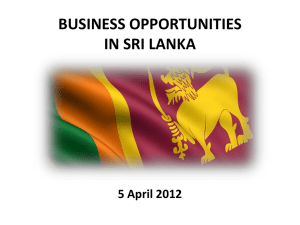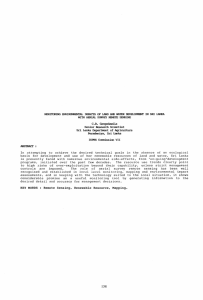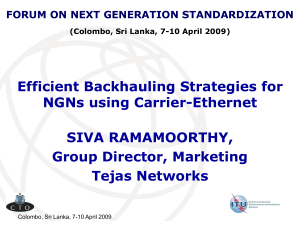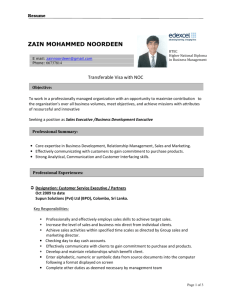Need of Interoperability “within” an NGN – An approach Rajeshwar Dayal, Director
advertisement
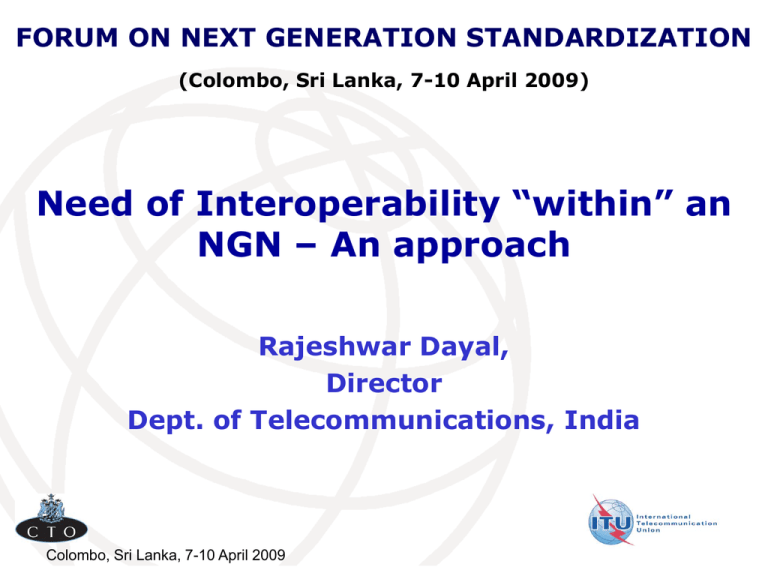
FORUM ON NEXT GENERATION STANDARDIZATION (Colombo, Sri Lanka, 7-10 April 2009) Need of Interoperability “within” an NGN – An approach Rajeshwar Dayal, Director Dept. of Telecommunications, India Colombo, Sri Lanka, 7-10 April 2009 What interoperability means for : ITU – The ability of two or more systems or applications to exchange and mutually use information that has been exchanged ( Y.101) the ETSI – Capability to provide successful communication between end users across a mixed environment of different domains, networks, facilities, equipments etc. ( TR 101 287) - where one component, from one manufacturer, can be replaced with another, and the basic operation of system remains unaffected. (TR 102 136 ) IETF – The ability of software and hardware on multiple machine from multiple vendors communicate meaningfully. ( RFC 1983) Colombo, Sri Lanka, 7-10 April 2009 to 2 Context of interoperability No common definition or context Multiple definitions by same SDO Network System Application Component Terminal/ CPE Software & Hardware Colombo, Sri Lanka, 7-10 April 2009 3 Interoperability –Between networks and within a network Operator B Operator A SIP Application Server Network B WEB Portal Network A Within a network there are various network elements, systems, equipments, Components…… Colombo, Sri Lanka, 7-10 April 2009 Router VOIP Gateway 4 Network Expansion Case 1– Same vendor Network from Vendor A SIP Application Server Expansion equipments from Vendor A WEB Portal Router Smooth expansion VOIP Gateway Interoperability is ensured Colombo, Sri Lanka, 7-10 April 2009 5 Network Expansion Case 2 –Different vendor Network from Vendor A Expansion equipments from Vendor B & vendor C SIP Application Server WEB Portal Router Network Expansion ??? VOIP Gateway Interoperability Missing Colombo, Sri Lanka, 7-10 April 2009 6 Need of interoperability ‘within’ NGN More modularity in the network Comfort of plug-and-play More competition Faster and smooth deployment Eliminate locking up with vendor Need of time Scenario of convergence & merger ITU-T Objective of NGN (Y.2001)-Fair competition Resolution 2- Mandate & responsibility of SG13 Colombo, Sri Lanka, 7-10 April 2009 7 Current approach to achieve Interoperability Testing against Conformance and Interoperability Test Suits Interop Events .. Plugtests Plugfest Bake off Colombo, Sri Lanka, 7-10 April 2009 8 Why Interop. is not a natural outcome of conformance to standard ? Misinterpretations : Ambiguity, Not complete ( Normal Expected behavior but what if unexpected happens) Multiple options for implementation Difficult to interpret Flexibility - for consensus or … interests Not comprehensive - cross references Colombo, Sri Lanka, 7-10 April 2009 9 What is specified by ITU for NGN Functional architecture ( Y.2012) ANI Applications ANI NNI UNI Management Functions Application Support Functions & Service Support Functions Service User Profiles Service Control Functions Service stratum Network Attachment Control Functions Transport User Profiles End-User Functions Resource and Admission Control Functions Other Networks Transport Control Functions Transport Functions UNI NNI Transport stratum For interworking and interoperability at network boundary level. Control Media Management Colombo, Sri Lanka, 7-10 April 2009 10 What is specified for ‘within’ NGN ? Applications ANI Application Support Functions & Service Support Functions Functional Architecture •Q.3030 Management Functions •Y.2012 Signalling Architecture for service control plane Colombo, Sri Lanka, 7-10 April 2009 Service User Profiles Service Control Functions Service stratum “Within” NGN Network Attachment Control Functions Transport User Profiles End-User Functions Resource and Admission Control Functions Other Networks Transport Control Functions Transport Functions UNI NNI Transport stratum Control Media Management 11 What is required for interoperability ‘within’ an NGN? Standards providing : Architecture identifying interoperable Functional / Physical Entities and their open interfaces. Requirements, spelt out unambiguously & comprehensively, for such open interfaces covering aspects such as its applicable stacks /layers, protocols & their profiles for interoperability, technology specific interfaces / protocols, etc. Colombo, Sri Lanka, 7-10 April 2009 12 From existing architecture to An architecture with open interfaces Multi-vendor equipments SIP Application Server WEB Portal Router VOIP Gateway Interoperability OpenMissing interfaces Colombo, Sri Lanka, 7-10 April 2009 13 Conclusion (1/2) Steps to bring interoperability as natural outcome of conformance to standardsStandards / Recommendations need to be categorized e.g. for ‘Protocol’, ‘Network’, ‘Equipment’, ‘Services’. A template & checklist need to defined/ developed for each, to address interoperability. e.g. physical equipment aspect ( and not only functional aspects) in standards related to equipments. Colombo, Sri Lanka, 7-10 April 2009 14 Conclusion (2/2) Mechanism need to be worked out for : Testing of Standards - before final approval. - may be those required for developing interoperable equipments or services - testing infrastructure e.g. ITU-ZNIIS ITTC Feedback - from developers, implementers, users, testing / certifying agencies, etc. e.g.Resolution-44, Forums of Interop Events Synergy of related activities at ITU & SDOs. e.g. JCA-CIT, SG-17,SG-11, ITTC, Res. 44 Colombo, Sri Lanka, 7-10 April 2009 15 Thank You Colombo, Sri Lanka, 7-10 April 2009 16




